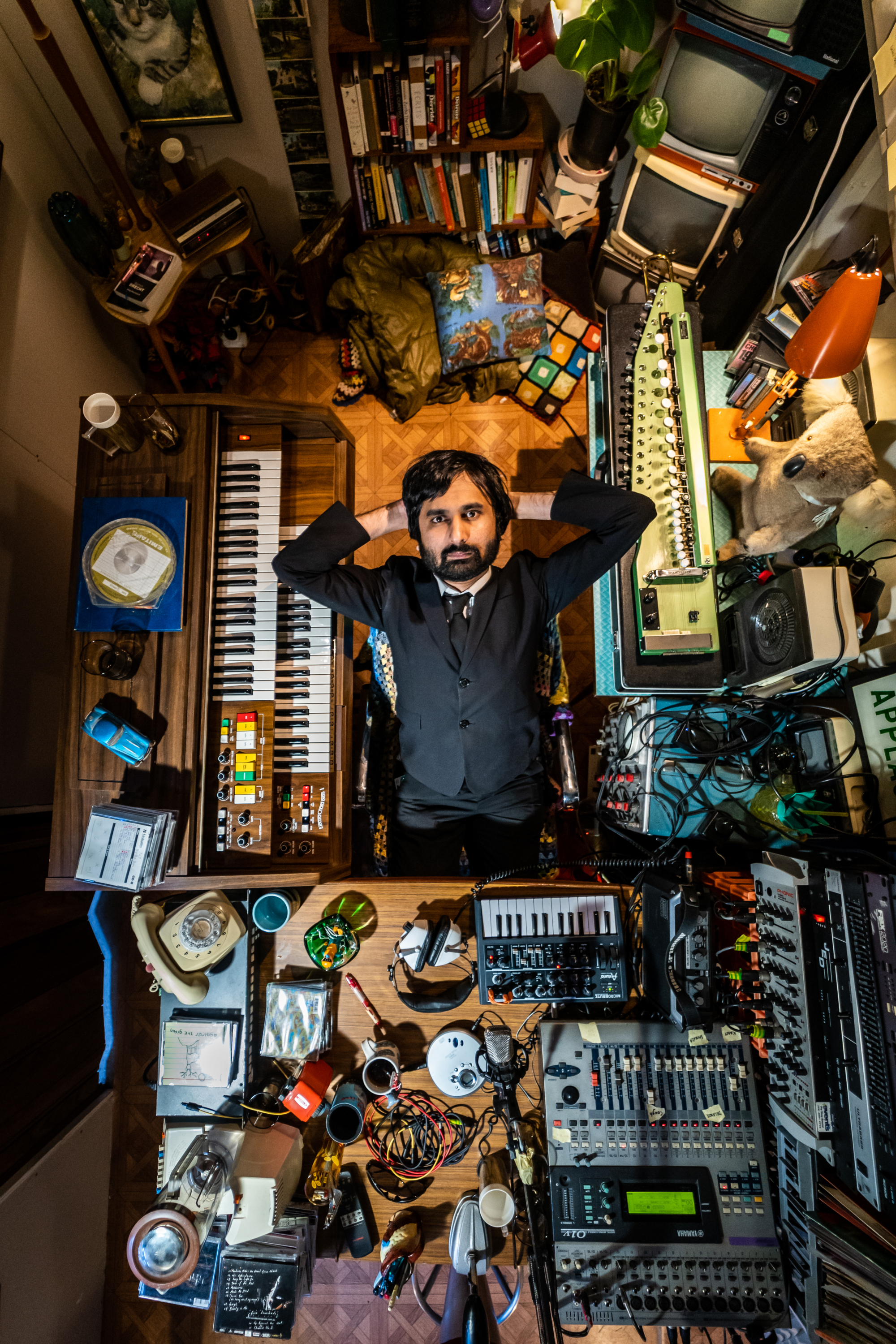For decades, the radio show was the pinnacle of at-home entertainment. Across Australia, people would settle down in the evenings to listen to live musical performances, scripted dramas performed by famous radio stars and discussions on topics of the day. Yet the radio was a means of connection as much as a form of entertainment: in the late 1920s, for example, the New South Wales government believed that radio would help slow the drain of people from regional areas into cities by allowing rural populations access to metropolitan culture and discourse.[1]See ‘Praise for Radio’, The Daily Telegraph, 23 March 1928, p. 7, available at <http://nla.gov.au/nla.news-article245429131>, accessed 5 October 2022. It could be argued that there are invisible links between people listening to the same story or piece of music at the same time, no matter how far apart they may be.
These days, of course, the advent of on-demand platforms such as Spotify and podcasts have facilitated more discrete, atomised listening practices. Compared with live radio, these allow for a greater degree of choice in terms of both content and scheduling; indeed, art curator Manuel Cirauqui suggests that ‘in times of customized listening and interference-phobia, the transistor behaves like a living fossil’.[2]Manuel Cirauqui, ‘Thanatophonics: From White Noise to Forensic Radio’, PAJ: A Journal of Performance and Art, vol. 35, no. 2, 2013, p. 20. Yet, despite all the advantages of this transition, perhaps something has also been lost. Studies have suggested that those who regularly call in to radio shows are motivated in part by a ‘need for social interaction’ and a desire to feel ‘“connected” to a community of other callers’.[3]Sarah Gillman, ‘“Stay on the Line” … an Analysis of Callers to Talkback Radio in Australia’, Media International Australia, vol. 122, no. 1, February 2007, pp. 188, 189. Perhaps this is true not only for a radio show’s listeners but also for the host.
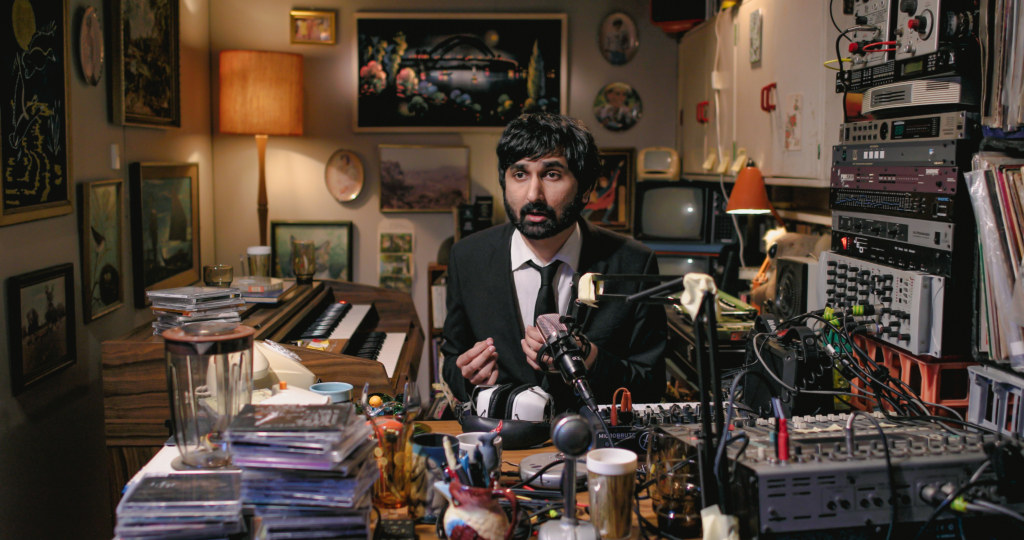
Platon Theodoris’ 2022 feature The Lonely Spirits Variety Hour resurrects the radio show in a decidedly eclectic fashion, placing it at the centre of an exploration of connection, loneliness and modern life. An adaptation of Nitin Vengurlekar’s stage production of the same name, the film stars Vengurlekar – who also shares a screenplay credit with Theodoris – as protagonist Rabindranath Chakraborty, who hosts the titular radio program under the alias of ‘Neville Umbrellaman’. Broadcast late at night from his parents’ garage, the show offers a true variety of content: unusual monologues; eccentric special guests; ‘all your favourite public-domain hits’; and, gradually, insights into the personal life of its loquacious yet emotionally reticent host.
As a film about an AM radio show, The Lonely Spirits Variety Hour is fittingly appreciative of the strange, the dated and the incongruous.[4]The AM radio band has seen a decline in the number of stations as well as listeners in recent years. See Brad Smart, ‘Life After Death: The Future of AM Radio’, Radio Today, 26 April 2016, <https://radiotoday.com.au/life-after-death-the-future-of-am-radio/>, accessed 5 October 2022. The film takes inspiration from Spike Milligan and Jacques Tati,[5]‘About’, The Lonely Spirits Variety Hour official website, <https://www.lonelyspiritsfilm.com/about>, accessed 5 October 2022. each an actor and writer (and, in the latter’s case, director) whose works offer absurdist takes on everyday situations – an influence that is evident from the film’s opening. After greeting his listeners, Rabindranath begins his show with a monologue about meeting a man who represented a company that ‘mass-produced reality’: ‘For five dollars, you could buy a forty-minute wait at a bus stop,’ he explains mildly. ‘For a more substantial payment, you could subscribe to a year’s worth of a major depressive disorder.’ The film cuts to this very conversation, with the two men standing calmly before one another in a vintage-styled cafe, both speaking in Rabindranath’s voice. The stripped-back editing of this sequence highlights the strangeness of the situation, creating a dreamlike and thoroughly absurd tone.
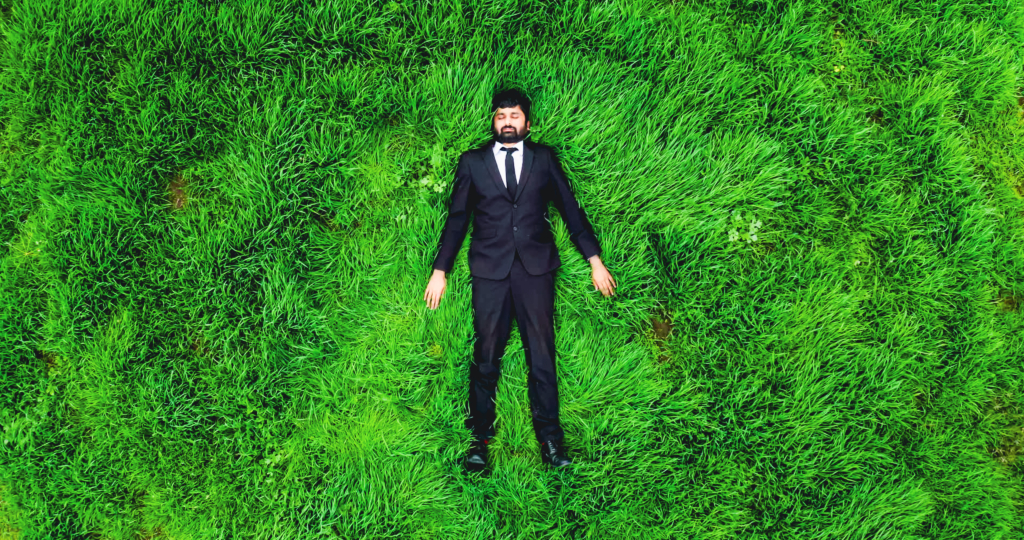
In his well-known treatise on the absurd ‘The Myth of Sisyphus’, Albert Camus contends that absurdity is a matter of incongruity:
The world in itself is not reasonable […] but what is absurd is the confrontation of this irrational and wild longing for clarity whose call echoes in the human heart. The absurd depends as much on man as on the world.[6]Albert Camus, ‘The Myth of Sisyphus’, The Myth of Sisyphus and Other Essays, trans. Justin O’Brien, Vintage International, New York, 1991 [1955], p. 21.
In other words, the absurd stems from the seriousness with which humanity pursues its quest for meaning within an indifferent world. The strangeness of Rabindranath’s story, performed in his serious, professional tone, creates an absurd world situated somewhere between reality and fantasy. There’s a similar incongruity between the quirky, mismatched decor of his garage studio and his formal suit-and-tie broadcasting attire. It’s clear that Rabindranath takes his show seriously, which suggests we are supposed to as well – but with the program’s nonsensical subject matter and lack of clear narrative direction, it’s difficult to decipher what it all means.
The film is soon anchored, however, by an incursion of reality. The warm colours and cluttered knick-knacks of Rabindranath’s garage studio are replaced by a sparse, sterile hospital room. ‘Neville’ lies unconscious in the bed, a close-up shot of his wristband informing us that this is his lawful, daytime persona, Rabindranath. We learn that he woke up with a headache that morning and took an Uber to the hospital, and that it is now uncertain whether he will ever regain consciousness.

This revelation reframes the scenes of the radio show that follow, shifting the film’s tone from pure whimsy to something deeper. Despite the doctor’s insistence that Rabindranath’s brain is exhibiting no signs of activity, the Variety Hour continues, with the doctors and nurses in the hospital soon incorporated into the show as eccentric special guests. As these strange, comic scenes unfold, so too do more serious questions: Is Rabindranath really brain dead? Are the scenes of the radio show dreams, memories or something else entirely? Who is Rabindranath, and what purpose does the radio show serve?
As these strange, comic scenes unfold, so too do more serious questions: Is Rabindranath really brain dead? Are the scenes of the radio show dreams, memories or something else entirely? Who is Rabindranath, and what purpose does the radio show serve?
While The Lonely Spirits Variety Hour’s theatrical origins can be glimpsed in certain aspects of its staging as well as its use of monologues, Theodoris takes advantage of the cinematic form to present his protagonist’s predicament in creative ways. In one scene, Rabindranath lies in a grassy field as the camera moves upwards until he is swallowed up by the green vastness around him; in another, he sits at a desk outside at night, speaking into the darkness. These scenes reinforce the film’s existentialist aspects, suggesting that Rabindranath is looking for something to grab on to, searching for meaning in the face of the universe’s indifference.
One recurring motif sees Rabindranath inspecting various ‘big’ roadside tourist attractions around Australia, such as the Big Lobster in Kingston SE, South Australia, and the Big Merino in Goulburn, New South Wales. The revelation that Rabindranath has suffered a brain issue, for example, is illustrated by him climbing into the mouth of the Giant Murray Cod in Swan Hill, Victoria. It’s a strangely fitting metaphor for his situation: he is heading into a darkened place he hasn’t been before, and it is unclear if he will make it out.
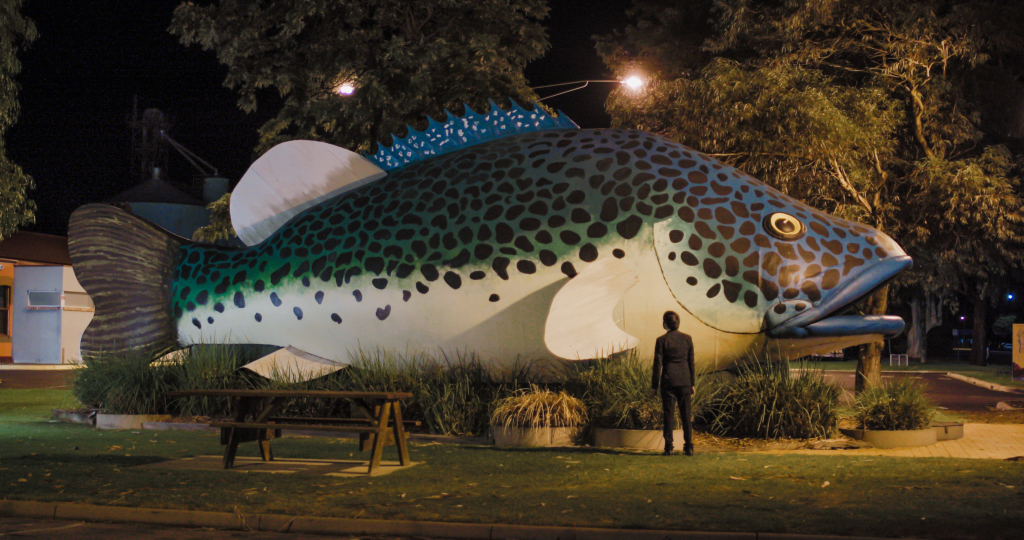
It’s also an apt metaphor for the film itself, which dives into Rabindranath’s interior world – a world illustrated through clever production design.[7]Theodoris was nominated for the Blackmagic Design Australian Innovation Award at the 2022 Melbourne International Film Festival for the film’s outstanding production design. Alongside his keyboard and broadcasting equipment, his studio is crammed with souvenirs, kitschy artwork, toys, vintage appliances and clothing. None of these items are particularly practical or aesthetically uniform; yet, when placed together in the garage, they form a nostalgic collage of Australiana. The prominence of tourist paraphernalia and roadside attractions among the set decoration foregrounds the idea of memory, suggesting that the garage is a metaphorical repository for Rabindranath’s experiences and interests. Exterior shots of the garage at night, with a sliver of light visible above the door and the sound of muffled music emerging from within, suggest that the shed itself represents Rabindranath’s brain, its neurons still firing within an otherwise still and dark body.
The set decoration of the studio also offers subtle revelations about its occupant’s insecurities. That Rabindranath has surrounded himself with so many collectibles and nostalgic items raises the idea that physical objects and hobbies can function as a kind of personal armour, with the aim of protecting their owner from life’s physical and emotional hazards. Early in the film, an elderly lady is shown listening to the Variety Hour while ensconced within three towering stacks of paperback books literally shielding her from the outside world. This staging mirrors the set-up of Rabindranath’s show: he is shown bedding down in a sleeping bag on the floor of the studio within the protective U-shape of his cluttered keyboards, broadcasting equipment and decor. Perhaps the eccentricity of the radio show, along with the Neville Umbrellaman persona itself, is something Rabindranath uses to cushion himself from the harshness of the ‘real’ world.
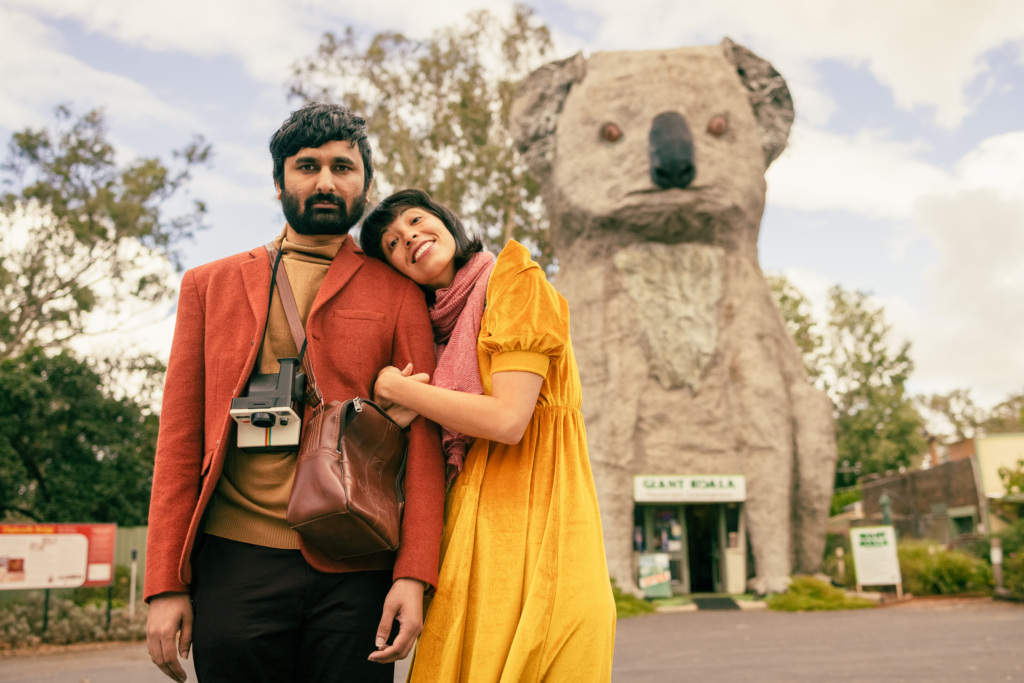
Yet, as the film explores, this desire for self-protection can result in disconnection from other people, including potential romantic partners. Billed as an ‘existential romantic comedy’,[8]A tagline used, for instance, in the heading of the film’s review screener. The Lonely Spirits Variety Hour offers a truly original take on the genre. As Rabindranath lies in hospital, his alter ego invites Sabrina (Sabrina Chan D’Angelo), a woman he works with, to perform on his show. He delays letting her into the studio, however, deferring instead to a musician named Kenneth, who performs an acoustic song about his cat, and an accent-shifting baker called Yvette, who appears out of nowhere to explain her recipe for bread (characters respectively played by Teik-Kim Pok and Alison Bennett, both of whom also appear as nurses in the hospital scenes). Sabrina is stuck outside, watching these bizarre guest appearances play out through the glass, all the while yearning to enter.
Given the parallels between the garage and Rabindranath himself, this is a clear metaphor for the latter’s reluctance to let someone into his heart, to allow Sabrina to see through the smooth-talking Neville Umbrellaman persona to the real person beneath. A tender moment sees Rabindranath and Sabrina on either side of the studio window, their hands placed over each other’s through the glass, their relationship stuck at this emotional impasse. A breakthrough finally comes when he at last lets her into the studio, which occurs simultaneously with her arrival at the hospital in the real world to visit the unconscious Rabindranath. Not long after she gets there, however, his family is informed that he is unlikely to survive.
The film also suggests another response to the absurdity of life – to look for others who may feel the same way, and to open oneself up to connections with both loved ones and strangers.
The severity of Rabindranath’s medical condition lends another meaning to the ‘spirits’ of the film’s title, raising interesting questions about death, legacy and radio. A voice speaking without a body is an inherently ghostly thing; indeed, since the 1950s, paranormal enthusiasts have explored the idea of ghosts using radio waves to speak to the living.[9]Cirauqui, op. cit., p. 22. There is, as Cirauqui notes, ‘an idea of spectrality, facelessness, and topological mystification that pervades the entire medium’ of radio.[10]ibid., p. 20. Rabindranath’s affinity with radio thus offers something of a consolation to both his grieving family and the audience; just as a ghost might live on through snatches of speech over radio waves, Rabindranath may live on through his relationships with family and friends. Indeed, by the film’s end, Sabrina’s voice is heard coming through the airwaves, continuing his show with an absurd monologue of her own. While the show has ended, the spirit of ‘Neville’/Rabindranath lives on via the people who knew him.
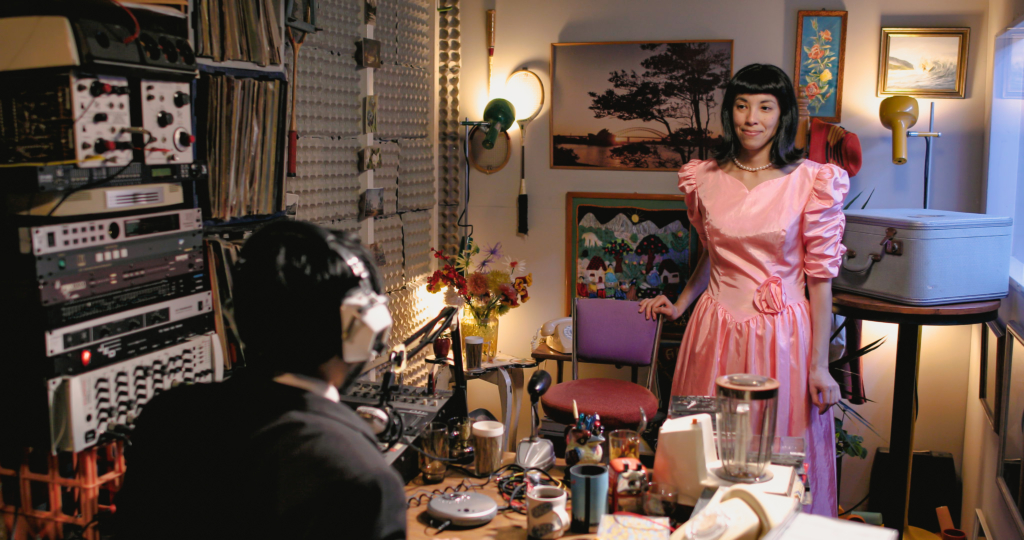
After his death, Rabindranath’s family clears out his studio, removing the broadcasting equipment and decorations and returning it once more to a mere garage. The vibrant world of the Variety Hour is deconstructed and consigned to a single dumpster, allowing space for reflection on what it all meant. Until this point, the show has been a way for Rabindranath to deal with the complexities of modern life, offering an inversion of reality in which the strange becomes ordinary and the ordinary strange. Within the studio, ‘normal’ life can be cut down and examined as a whimsy, like the bite-sized chunks of reality sold by the man he meets in the cafe. The show exists in a world that understands that events such as Rabindranath’s illness can strike suddenly, without warning or meaning. In the face of such random, cosmic indifference, the only response – as Camus suggests, and the Variety Hour embodies – is the recognition and, in turn, acceptance of this absurdity.
Yet the film also suggests another response to the absurdity of life – to look for others who may feel the same way, and to open oneself up to connections with both loved ones and strangers. In the same way that AM radio signals travel further at night,[11]See ‘Why Do You Hear Some Radio Stations Better at Night than in the Day?’, HowStuffWorks, 1 April 2000, <https://electronics.howstuffworks.com/question1.htm>, accessed 5 October 2022. reaching more listeners, Rabindranath’s late-night radio show seeks out other people who may have felt out of place or awkward in the world, connecting them with one another.
The film ends with a sequence of shots of these very people listening to the Variety Hour, now performed in Sabrina’s voice: a student writing by a window late at night; a woman sitting at her kitchen counter; a man working on his car; a woman relaxing in a bubble bath. The calm, methodical cuts between these shots suggest a common link between them: while they are each alone, they are all accompanied by the disembodied voice floating out of the radio. And while they cannot see or speak to one another, they are each accompanied in their solitude by other listeners, each reassured by the knowledge that there are other ‘lonely spirits’ out there who are, in some small way, like them.
https://www.lonelyspiritsfilm.com/
Endnotes
| 1 | See ‘Praise for Radio’, The Daily Telegraph, 23 March 1928, p. 7, available at <http://nla.gov.au/nla.news-article245429131>, accessed 5 October 2022. |
|---|---|
| 2 | Manuel Cirauqui, ‘Thanatophonics: From White Noise to Forensic Radio’, PAJ: A Journal of Performance and Art, vol. 35, no. 2, 2013, p. 20. |
| 3 | Sarah Gillman, ‘“Stay on the Line” … an Analysis of Callers to Talkback Radio in Australia’, Media International Australia, vol. 122, no. 1, February 2007, pp. 188, 189. |
| 4 | The AM radio band has seen a decline in the number of stations as well as listeners in recent years. See Brad Smart, ‘Life After Death: The Future of AM Radio’, Radio Today, 26 April 2016, <https://radiotoday.com.au/life-after-death-the-future-of-am-radio/>, accessed 5 October 2022. |
| 5 | ‘About’, The Lonely Spirits Variety Hour official website, <https://www.lonelyspiritsfilm.com/about>, accessed 5 October 2022. |
| 6 | Albert Camus, ‘The Myth of Sisyphus’, The Myth of Sisyphus and Other Essays, trans. Justin O’Brien, Vintage International, New York, 1991 [1955], p. 21. |
| 7 | Theodoris was nominated for the Blackmagic Design Australian Innovation Award at the 2022 Melbourne International Film Festival for the film’s outstanding production design. |
| 8 | A tagline used, for instance, in the heading of the film’s review screener. |
| 9 | Cirauqui, op. cit., p. 22. |
| 10 | ibid., p. 20. |
| 11 | See ‘Why Do You Hear Some Radio Stations Better at Night than in the Day?’, HowStuffWorks, 1 April 2000, <https://electronics.howstuffworks.com/question1.htm>, accessed 5 October 2022. |
